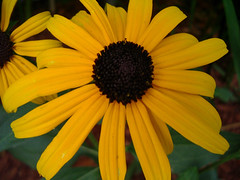Growing Black-eyed Susans
A popular native plant
Name: Black-eyed Susan (Rudbeckia hirta)
Height: 1-3 feet (30 – 90 cm)
Blooming period: Summer to fall
Exposure: Full sun to partial sun
Moisture: average to dry; drought tolerant
Habitat: dry meadows, prairies, open woods
Range: Northeastern, and prairie areas of North America
The Rudbeckia is one of the most popular of the native wildflowers.
Black-eyed Susans are a must in the meadow or prairie garden. It’s prolific, long lasting blooms – yellow with dark centers – and its ease of cultivation make it a rewarding plant. Although it’s often listed as a biennial, black-eyed Susan will behave as a perennial if it’s happy and an annual if it’s not.
Maintenance and Requirements:
Black-eyed Susan thrives in tough conditions – in sandy or gravelly, nutrient-poor soil and long periods of drought. Don’t supplement the soil with fertilizer or organic material such as compost before planting, as you don’t want the soil to be too rich. If the soil is too rich there will be few blooms and and weaker stems. Acidic to neutral soil, clay or sand are best for this easy plant.
Propagation:
Easty to start from seeds, which ripen in fall, or divide mature plants in early spring or in fall.
Good Companions:
Black-eyed susan looks great with almost any of the native prairie and meadow species, but it looks particularly nice with airy white flowers such as flowering spurge (Euphorbia corallata), Pearly everlasting (Anaphalis margaritacea), and with the brilliant orange butterfly weed (Asclepias tuberosa), or the deep blue-purple of Delphinium exaltatum.
My own Black eyed susan plants (Rudbeckia fulgida ‘Goldsturm’) are planted near purple Salvia nemorosa, White phlox (Phlox paniculata ‘David’), and a Hosta Gold standard.
Related Species:
Brown-eyed Susans (R. triloba) has smaller blossoms, but they are more abundant than R. hirta, and the whole plant is bushier, with many branches. Sweet black-eyed Susan (R. subtomentosa) is much taller, to 6 feet (1.8 m). Green-headed coneflower (R. laniniata) is also very tall (3 to 8 feet /.9 to 2.4 m) and grows in the open shade of woodlands or in sun, blooming in summer.
Wildlife:
Nectar attracts butterflies and bees.

I’ve been scowering the internet all nite looking for an explanation for my droopy black eyed susans. I just replanted in a sunnier spot in the garden and dug up the soil (very bad, lots of clay) and replaced with some older potting soil from containers that I recycled. I watered alot and did not compress soil very much before putting in the flowers. So near as I can figure, your comment about rich soil, plus another comment I found about compressing the soil near the roots to prevent air pockets, are the likeliest culprit. If you have any other advise, pls post.